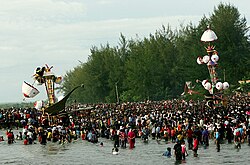
Below is a list of festivals in Indonesia. The list is divided based on their respective calendar.

Below is a list of festivals in Indonesia. The list is divided based on their respective calendar.



Traditional Chinese festivals in Indonesia are usually known under their Hokkien names, with several dialects exist some cities e.g. Medan and Bagansiapiapi.
| Date (Chinese calendar) | English name | Indonesian name | Mandarin name | Hokkien name | Hakka name | Remarks |
|---|---|---|---|---|---|---|
| 1st date of 1st month | Chinese New Year | Tahun Baru Imlek | 農曆新年 农历新年 (Nónglì Xīnnián) | 1st day of 1st month of Chinese calendar. Public holiday since 2003 | ||
| 15th date of 1st month | Lantern Festival | Festival Lampion | 元宵節 元宵节 (Yuánxiāo Jié) | 十五暝 (Cha̍p Gō͘ Mê) | Festival marking the last day of Chinese New Year celebration. | |
| 15th day after vernal equinox | Qingming Festival | Festival Qingming | 清明節 清明节 (Qīngmíng Jié) | 清明節 清明节 (Chheng Bêng Chat) | ||
| 5th day of 5th month | Dragon Boat Festival | Peh Cun | 端午节 端午節 (Duānwǔ Jié) | 扒船 (Pê Chûn) | 端陽 (Tôn-yòng) | |
| Bakar Tonggang Ceremony | Ritual Bakar Tonggang | 儀式燃料的駁船 仪式燃料的驳船 (Yíshì Ránliào de Bóchuán) | 五月十六日 (Gō͘ Go̍eh Cha̍p La̍k Ji̍t) | |||
| 15th night of the 7th month | Ghost Festival | Festival Cioko | 鬼節 鬼节 (Guǐ Jié) |


This list includes festivals which don't follow any of the previous calendars, such as the Balinese pawukon and saka calendar.
